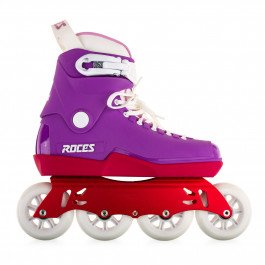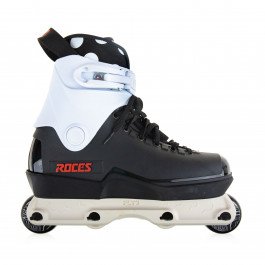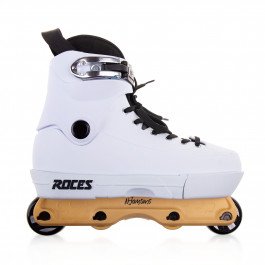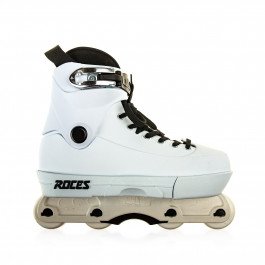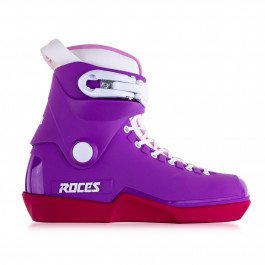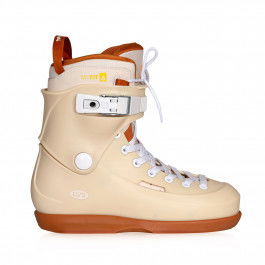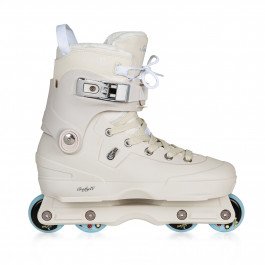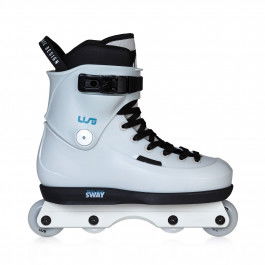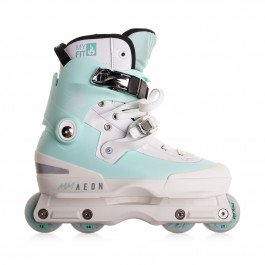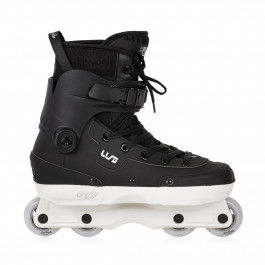If you are fresh to all of skating related stuff, you may wonder what are key differences between different types of inline skates. Even tough their general blueprint is always the same and can be distilled to just three key elements (boot, frame, wheels), things get more complicated when we go outside of recreational and fitness skating realm.
One of oldest styles which emerged from primordial soup of early inline skating is street skating or, as it is more frequently called, aggressive inline skating. Sometimes the broader term “rollerblading” is used, but this can be a catchphrase for all types of our favourite activity and also comes from Rollerblade company name. It does make some things difficult from legal perspective i.e. other companies cannot call their skates “rollerblades”.
Aggressive skating is one of several urban “action sports” and exist in the same space as skateboarding, BMX or the most recent addition, stunt scooters. The skates made for it are used not just for rolling around, but first and foremost intended for sliding on ledges and rails (grinding), performing jumps, quite often with spins in more than one axis (flips) while holding one or both skates with your hand (grabs). These elements are often chained together in sequence – for example, a skater can make a jump with 180 spin, onto a ledge and into a grind, then while sliding do a little hop with another spin or readjust position of the feet to perform different grind and finally jump off holding a grab before landing.
If you take a look at what rec/fitness skates look like, it will be obvious that they are not suited to tricks and stunts. The aggressive inline skates have started to naturally evolve from early hardboot ones, which were easy to mod using tools and materials available at home. Over time, companies have started to adopt ideas introduced by skaters themselves. Thus, how aggressive skates look nowadays is as much a result of technical advancements by companies, as it is a result of “grassroots” creativity.
Below you can see infographics with skate elements highlighted, as well as read description of all major elements forming a modern aggressive inline skate.
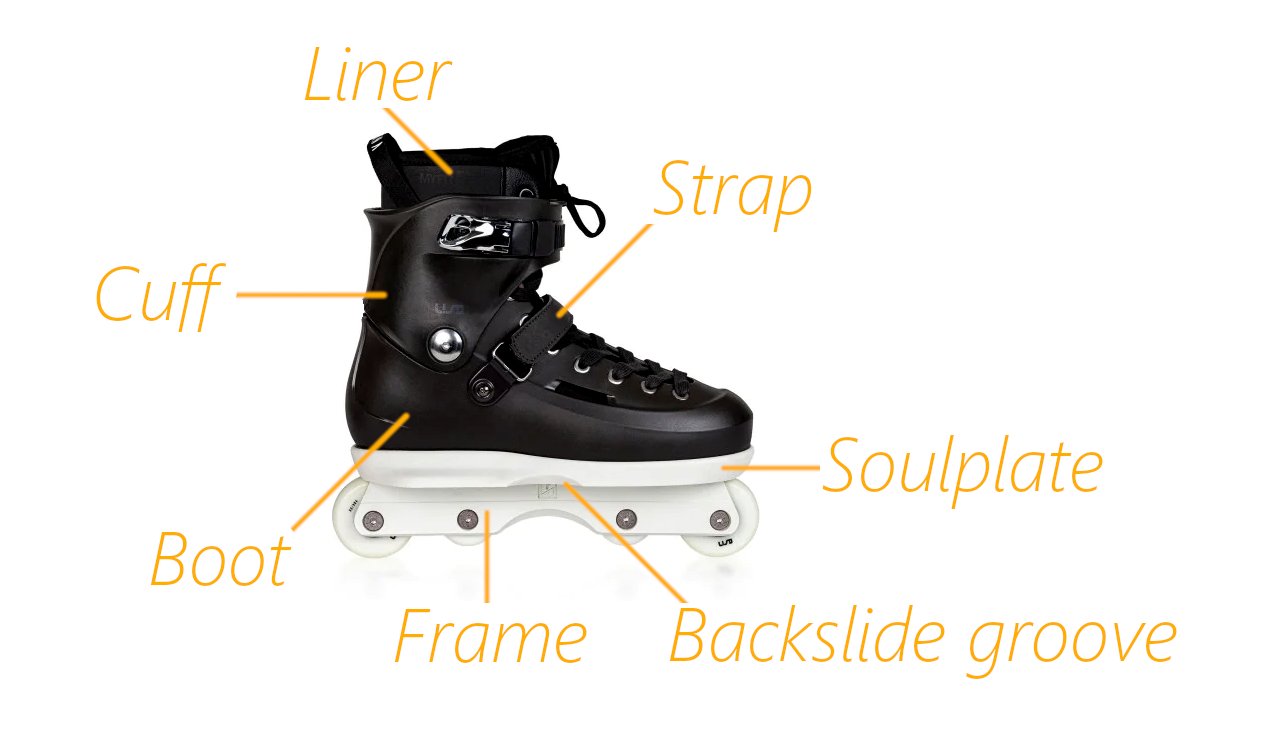
Boot
It is a central part of the skate, as all other elements are attached to it directly or indirectly. Boot is responsible for giving your feet proper support and protection, ensuring good fit, which holds it in place. It is crucial to pick a correct boot size, one which will provide a tight fit – it it will be too loose, skates will break down faster, cause abrasions and will be harder to control and skate in general. There’s an ongoing myth that you should leave 1 cm of space inside the boot to not bump your toes – but properly sized and good fitting boot won’t allow your foot to move forward inside of it, so there’s no risk of injury here. Don't buy loose skates, they will break-in and start to feel like boats over time.
Aggressive inline skating boots are most frequently based around one of two concepts:
- Composite hardboot, full shell: injection molded plastic shell with liner inside. Liner is an inner boot which can be taken out and replaced if needed. It provides padding, wraps around your foot and ensures proper level of comfort.
- Partial, internal composite or carbon shell with softer upper. Usually the padding is fully integrated and boot resembles a sneaker shoe, although for obvious reasons, is much more rigid. Such skates are sleeker and lighter than hardboots.
Boot can come equipped with built-in shock absorber, which is a wedge made out of softer material (usually urethane or some kind of rubber) and is placed under your heel. It dampens the shock on landings a little, making them easier on your joints and knees.
Boot can be equipped with midstrap (45 degree strap) which can be either a plastic buckle or Velcro. It is used to allow for better heel lock. Majority of aggressive skates do not have this part, though. There’s a very simple reason for this – due to nature of grinds, it is very easy to damage this element if you fall and hit the ledge or rail with your boot. Thus, proper lacing is extremely important – we recommend investing into good quality waxed hockey laces, they do the job of keeping your heel locked in place very well.
Cuff
This part is responsible for stabilising your ankle by providing support to the sides. Aggressive skates often have softer cuffs than freeskates. Better flex makes performing certain tricks easier. Thanks to small size of wheels and in turn, lower centre of gravity, the increased flex is not really an issue when it comes to securing the ankle position while rolling around.

Cuff is usually mounted with two screws, which allows for front to back movement. This makes it a lot easier to jump in skates. Closure can be either a plastic buckle or more flexible Velcro strap.
Liner/padding
Depending on the boot type, we have a separate liner (inner boot) or integrated padding. In both scenarios, foams are anatomically shaped to deliver comfort and necessary heel lock. Insole resides below the foot.
Some skates and liners use thick and soft foams, others are opposite – they are slimmer, more rigid. Both concepts have their loyal fans, but there’s a trend among more advanced skaters to favour the latter type, as it increases control and performance.
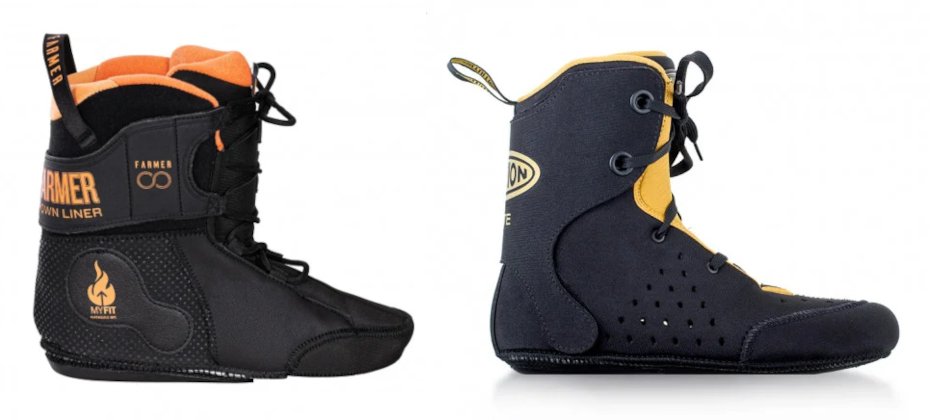
Liners can be laced, some can be heat-molded, just like in ski boots. It is worth to note that there are manufacturers of liners, offering multiple models, which are sold separately. MyFit is the leading brand here when it comes to range of liners, while Intuition releases a couple of models of super high quality. Using a right liner, you can tune hardboot skates to your needs even better. However, if you are just getting into the sport, do not worry about this kind of stuff – choose a stock setup which fits your feet best.
As for the skates with integrated padding - they are 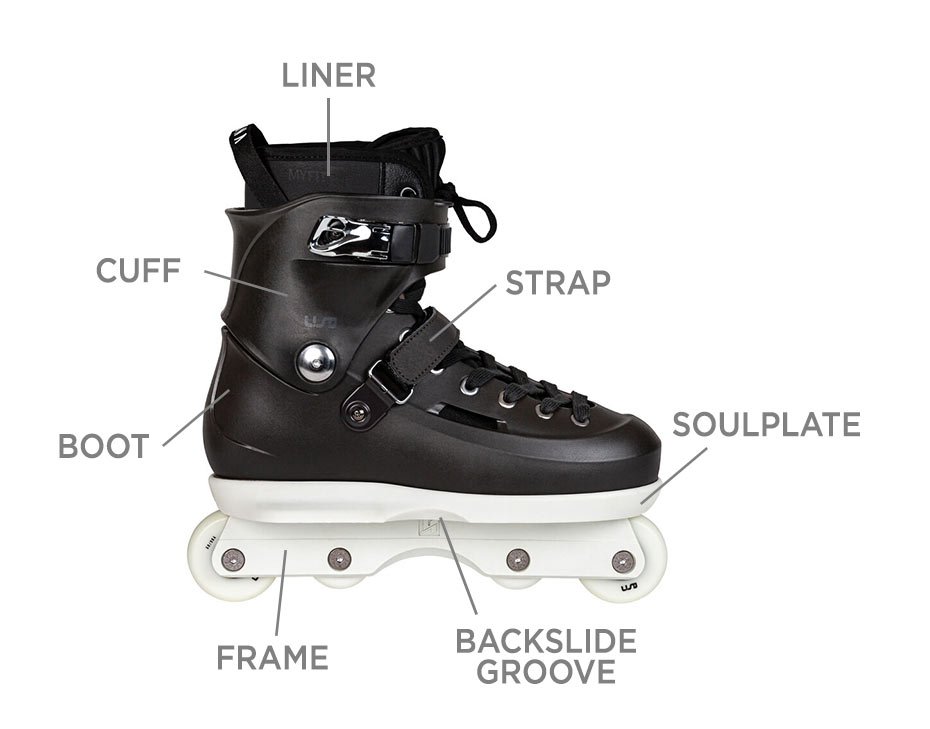 built using the same materials, but as a whole slimmer and weight less. They give more direct contact with skate and improved responsivenes. A classic example of such skates are USD Carbon.
built using the same materials, but as a whole slimmer and weight less. They give more direct contact with skate and improved responsivenes. A classic example of such skates are USD Carbon.
Some liners come with shock-absorber attached by Velcro to their underside.
Soulplate
This element is unique to aggressive skates. Word “soulplate” comes from “sole plate” which is simply a flat surface, mounted to boot's sole, to slide on. Most of the time, soulplate comes in between the boot and frame.
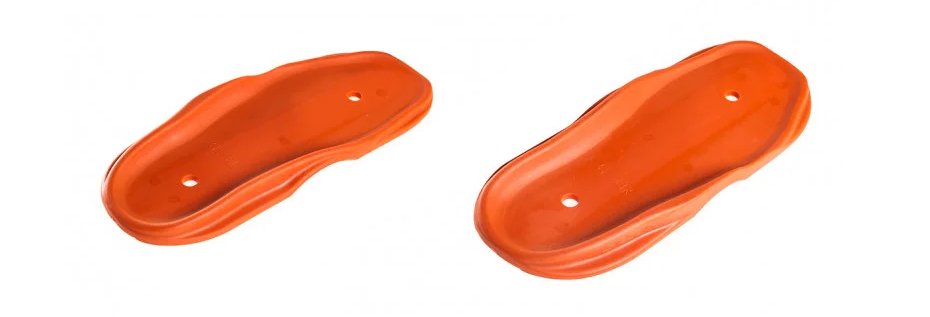
It is used to perform grinds. Soulplates have backslide groove, which is pre-shaped to allow you to lock better on grinds like royale, where you need to bend your knees very low and touch the rail/ledge with both frame and outer edge of the boot.
Some skates have an element called backslide plate – it is simply a plastic piece with backslide groove, separated from rest of the soulplate.

Frame
Frames in aggressive skates are used for two things. Their basic function is of course to hold wheels in place and allow them to spin. The secondary function is to allow for various kinds of grinds. For this, they are equipped with a special cut-out called groove. Similarly to one found in soulplates, frame groove can be placed on replaceable component called H-block, just like one pictured below:

Most frequent size of aggressive inline wheels is up to 60 mm in diameter. Sometimes frames are made for wheels up to 72 mm or even bigger, but these models are made for people who have pretty good skill when it comes to grinding, as difficulty is increased on such tall frames with narrow groove. Beginners should opt for frames with fitting wheels of diameter between 54 mm and 60 mm.
Aggressive inline frames are made around UFS mounting standard, meaning that all of them fit UFS compatible boots. However, there are cases of skates where frame, soulplate and boot shell are all one, injection molded part – USD Aeon are the prime example. Kizer brand has released soulframes, which are nothing more than soulplate and frame integrated into single piece, fitting some of the boots on the market.
UFS standard allows us to create customised setups, so many companies offer their skates as boot only option in addition to complete ones.
Last thing worth to note in terms of frames are their varieties. There are three of them:
Flat frames
They are made to fit 4 wheels and still provide a decent grinding experience. Four wheels per skate give use great agility, better roll and speed. Thus, they are perfect for people who are only starting to learn proper skating technique. However, this type of setup also makes frame groove grinds harder, as there’s a risk of “wheelbite” when soft urethane of wheels gets in contact with rail/ledge, causing a sudden stop. At high speed, this will launch you forward and can result in injury. Some companies try to get around the issue by shaping groove in a special way, giving the inner wheels more protection. Kaltik frames are a good example here.

Antirocker frames
All flat frames can be used with antirocker wheel setup, however this doesn’t make sense in all scenarios.
Antirocker setup replaces two inner wheels with much smaller and harder ones – they are called grindwheels or antirockers. If they are made out of urethane, it is of hardness higher than 100A, however plastic, vinyl is used more frequently as a material. These wheels do not touch the ground, so we are rolling only on the outer ones. Grindwheels eliminate wheelbite and make locking into tricks easier.

If frame designed for flat setup does come with a decent level of wheelbite protection itself, grindwheels won't do anything. Thus, they are best suited to be used in "classic" style frames.
There are rare instances of frames which won’t accept flat setup as they are designed to be used with antirocker only, or will accept flat, but due to shape of their groove are not really usable that way for groove tricks. A good example of the latter kind are Ground Control Featherlite 3 frames - you can skate them flat, but wheelbite is guaranteed because middle wheels stick out of the sides of a groove so much.
If you already know how to skate and want to learn grinds, antirocker setup is the way to go. Turning is nowhere near as good as on flat and they give that "on rails" feeling, but easiness of performing tricks makes up for it.
Freestyle frames
Their popularity is very low nowadays, but some brands still make them. Such frames fit only two wheels and whole space between them acts as a giant groove. Experienced skaters often consider these frames as “cheating” and point to the fact that they cause people to learn “sloppy” grinding technique.

On the other hand, there are people who claim that riding freestyle expands a range of things you can grind on (which is true) and that they make it easier to slip-out on grinds due to worse "lock" on rail/ledge than in case of traditional H-block style frame.
These are definitely an acquired taste, good for skaters with certain style, who skate a lot of "rough" street spots. Beginners should stick to either flat or antirocker, though.
Rest of the parts
Apart from everything listed above, wheels and grindwheels, the skate is composed of:
- hardware (screws, bolts, rivets)
- wheel axles
- bearings
- bearing spacers
- frame spacers
Enthusiasts of aggressive inline skating often join parts of several different manufacturers, much like in case of every sport where tuning the gear is possible. This is a whole different subject, though – we won’t cover it here, as it requires a whole series of articles.
If you want to buy yourself some aggressive skates, you’ll find them here. Good luck at taking your first steps in this exciting sport!




